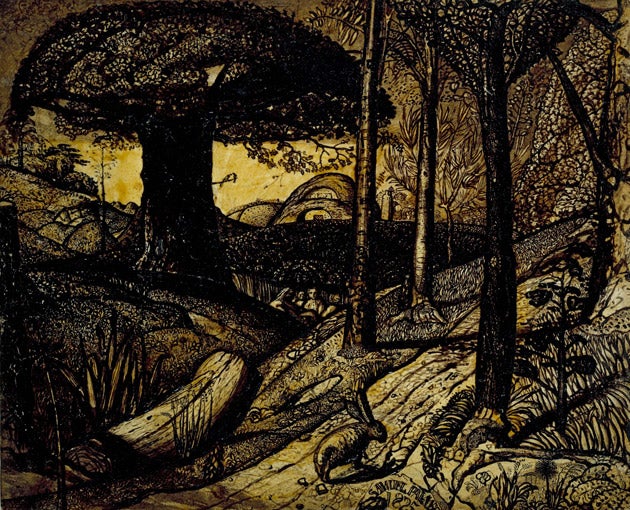Great Works: Early Morning (1825), Samuel Palmer
Ashmolean Museum, Oxford

Visionary often suggests blurry, misty, something vague. It's as if revelations always came with a loss of focus. The rational is distinct. The mystical is ghostly. We often see Turner as a visionary artist. After all, as Constable put it, his paintings resemble "tinted steam".
But when Aldous Huxley took mescaline, it was the sense of radiant clarity, of infinite detail, which overwhelmed him. He looked down at the folds of his trousers: "What a labyrinth of endlessly significant complexity! And the texture of the grey flannel – how rich, how deeply, mysteriously sumptuous." He said: "I was seeing what Adam had seen on the morning of his creation – the miracle, moment by moment, of naked existence... pure Being, a bundle of minute, unique particulars in which, by some unspeakable and yet self-evident paradox, was to be seen the divine source of all existence." The language here Huxley partly borrows from William Blake. "Every minute particular is holy..."
And it's the kind of vision you find in Blake's follower, Samuel Palmer – for example in his Early Morning. The picture shows a path running through a wood, near Shoreham in Kent, the out-of-town village that the young London artist had made into his personal rural paradise. It is first light. The sun rises behind the big, silhouetted tree, but deep shadows cling on. The scene takes a moment to come clear, as its dense sepia browns and gleaming golden whites resolve into recognisable objects.
But soon you make out that rabbit loitering in the foreground, and the rising log. In the background, there's the humped thatched cottage, and the curved field of high corn in front of it. Just in front of that there's the dip in the ground that discloses (surprisingly) a small group of people – a congregation at prayer, perhaps.
And as you look, you see that nothing in the scene is taken for granted, nothing is sketched or suggested. Each living organism has been individuated, defined with an emphatic shape. The elements of the world are seen afresh and newly named. The oak tree stands out, recast with the profile of a huge mushroom. The cottage is like a little pastry pie. The field of corn is like a loaf. It's the same with every little hummock and patch of grass, every single leaf and blade and ear and flower. Even as the scene retreats into the distance, nothing loses its identity in a blur of atmosphere. Palmer believes in individuality to the end. Each bit of creation has its iconic character, distinctly outlined. Delineated within their dark contours, nature's elements glow like the fragments of a stained glass window.
Our senses are made alive to nature's particulars, to its complexity. The ground and the foliage teem with numberless bits. Early Morning may avoid all blur, but its multiplicities are often ungraspable, made of particles so tiny that elude the eye. It is a small image, about seven inches by nine. You can peer into. You can put a magnifying glass to its surface and pick out its minutiae. It is a packed cellular world, a world under pressure, and what increases its pressure is the sense of enclosure. Small forms are contained in larger forms. Irregular forms are simplified. Nature is rounded up within firm curves, gathered into a flock of mounds. The breeding world brims against these boundaries.
This landscape is like a womb. Unlike the usual outdoors art of England, from Constable to Long, it has little interest in spreading land, in far horizons and open skies. Its forms are bounded. Its details proliferate. It holds and strains. Notionally a view of countryside, Early Morning is really a fecund vision of seeds and pods and cells. Deep nature.]
About the artist
Samuel Palmer (1805-81) has been called "the English Van Gogh". He was aprecocious, original artist. In his early twenties, inspired by Blake, Dürer and his own "primitive and infantine vision", he produced a series of miraculous rural scenes. He founded the first British avant-garde, the Ancients. He reacted to the modern world with medievalist Romanticism – "The past is for poets. The present for pigs." When his works were rediscovered in the 1920s, they influenced every British Modernist.
Join our commenting forum
Join thought-provoking conversations, follow other Independent readers and see their replies
Comments